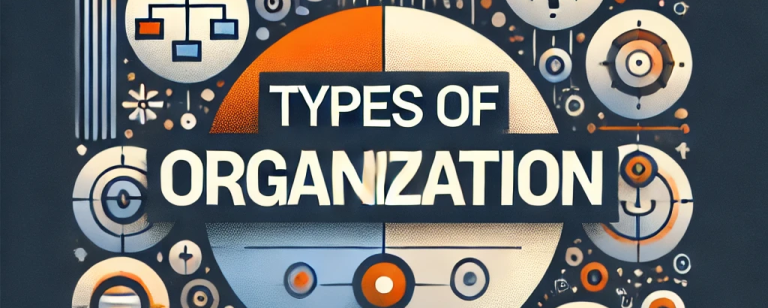Understanding the various types of organization is critical for grasping the diverse ways businesses and groups operate in society. Organizations are frameworks through which individuals come together to achieve shared objectives. They differ based on size, structure, goals, and modes of operation. These distinctions allow us to classify organizations into different types, such as formal and informal organizations. Each type serves distinct functions, playing a vital role in social, economic, and professional contexts. Understanding these types helps in leveraging their strengths for efficient collaboration and goal accomplishment.
Meaning of Organization
Organizations are organized bodies through which people come together to attain common objectives through coordinated efforts. Organizations play a significant role in every walk of life, whether it is business, education, or community activities. Different types of organization offer different systems for resource allocation, task assignment, and coordination of activities.
Importance of Organizations
- Provide a System for Task Allocation
Organizations ensure that tasks and responsibilities are divided efficiently among members based on their skills and roles. This reduces duplication of efforts and promotes accountability. - Facilitate the Effective Use of Resources
Organizations enable the optimal use of financial, human, and physical resources by implementing structured systems and processes. This leads to increased productivity and reduced wastage. - Aid in the Collective Achievement of Objectives
Organizations bring individuals together to work towards shared goals, fostering coordination and teamwork. This collective effort enhances the chances of achieving desired outcomes efficiently.
Types of Organization
Organizations play a vital role in shaping the functioning of societies and economies. They serve as structured frameworks where individuals work together to achieve common goals efficiently. By offering systems for task allocation, resource utilization, and collective action, organizations contribute to the success of both small-scale teams and large enterprises.
Formal Organization
A formal organization is a structured entity with explicitly defined roles, rules, and responsibilities. It operates under a well-documented framework that ensures consistency and accountability in achieving objectives.
Characteristics of Formal Organization
Characteristics define how they function, interact, and achieve their goals. Understanding these characteristics differs in their roles and contributions within diverse environments
- Clear Hierarchy of Authority: Roles are defined in a top-down structure to ensure order and accountability.
- Defined Roles and Responsibilities: Each individual has specific duties to avoid overlap and confusion.
- Formal Channels of Communication: Communication follows set paths, ensuring transparency and documentation. Policies ensure consistent and fair decision-making across the organization.
Advantages of Formal Organization
These are some of the benefits that depict their strengths in achieving organizational objectives and fostering collaboration among members.
- High Accountability: Defined roles ensure everyone knows their responsibilities and outcomes.
- Structured Decision-making: Decisions are made systematically, which means that errors are minimized and the process is fair.
- Predictable Operations: The processes follow a predictable pattern since rules and systems are followed.
Disadvantages of Formal Organization
These disadvantages can affect their efficiency and effectiveness, thus requiring strategies to minimize their effects.
- Rigidity to Change: Structures that are too rigid make it difficult to adapt to new situations.
- Inefficiency from Bureaucracy: Too many procedures can delay operations.
Examples of Formal Organizations
- Companies such as Apple Inc. and Microsoft.
- Schools and universities.
Informal Organization
An informal organization is formed naturally in a formal setup or on its own. It is based on personal relationships, social interactions, and common interests rather than on formal rules.
Characteristics of Informal Organization
The characteristics of an informal organization define its unique and flexible nature. These features arise from personal relationships and social interactions, which distinguish it from structured frameworks.
- Flexible Structure: It is flexible, and there are no fixed rules or hierarchies.
- Based on Relationships: It is based on trust, friendship, and social bonds rather than official policies.
- Casual Communication: The communication is spontaneous, often verbal, and informal.
Advantages of Informal Organization
The informal organization has several benefits, especially in the creativity, collaboration, and adaptability aspects. These benefits are usually complementary to formal structures, thus creating a balanced environment.
- Encourages Creativity: There is no rigid system that discourages innovation and new ideas.
- Boosts Team Morale: Relationships create a supportive and positive environment.
- Fast Communication: Quick and direct communication speeds up decision-making.
Disadvantages of Informal Organization
While informal organizations contribute positively, they also come with challenges.
- Lack of Accountability: Roles are undefined, making it hard to assign responsibility.
- Potential Conflicts: Personal biases and misunderstandings can create disputes.
Examples of Informal Organizations:
Informal organizations appear in many different contexts, from workplace social groups to community initiatives.
- Workplace social circles.
- Community groups based on shared interests or objectives.
Difference between Formal Organization and Informal Organization
Formal and informal organizations differ significantly in structure and function, with the former being intentionally designed to achieve specific objectives and the latter emerging organically to fulfill social and emotional needs within a group.
| Aspect | Formal Organization | Informal Organization |
| Definition | A structured system with defined rules and roles. | A natural formation based on personal relationships. |
| Structure | Rigid and hierarchical. | Flexible and unstructured. |
| Roles and Responsibilities | Assigned and documented. | Based on mutual understanding or interest. |
| Communication | Official and follows formal channels. | Casual and spontaneous, often verbal. |
| Rules and Regulations | Governed by written policies and procedures. | No formal rules; driven by social norms. |
Types of Organization FAQs
What is the difference between formal and informal organizations?
Formal organizations are characterized by defined rules, while informal organizations are fluid and based on relationships.
Why do formal organizations matter?
They guarantee accountability, uniformity, and proper resource allocation.
Can formal and informal organizations exist together?
Yes, informal organizations usually work within formal organizations to increase social bonding and informal communication.
What are some examples of informal organizations in the workplace?
Employee social clubs or informal teams created for a project.
How do organizations respond to change?
Formal organizations adapt through strategic restructuring, while informal ones rely on the natural evolution of relationships.


